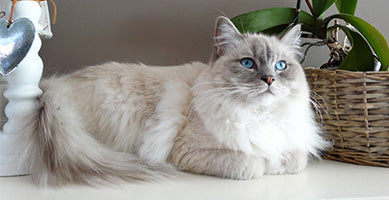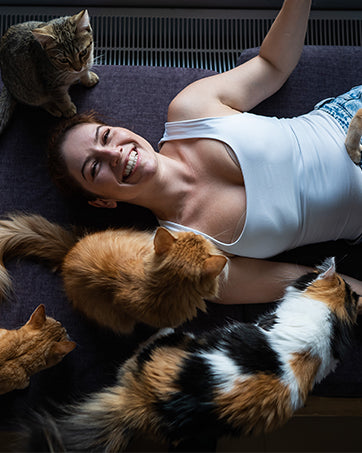Jessica W. Kelvin - Mar.05.2024
Why Do Cats Eat Grass?
7 Insights into Feline Behavior

How Long Do Cats Live?
Average Lifespan of a House Cat
Est. read time: 12 min.
CIt's no surprise that pet parents want to know what the average lifespan of a house cat is so they can gauge how long their adored feline friend will be around. Knowing the lifespan of your feline can help you understand what stage of life your cat is in and give you some emotional readiness as they age. It also helps to understand what health issues or behavioral quirks to look out for as your cat grows.
While no one can say exactly how long a cat’s lifespan is, statistics can give a general answer to the question. Every cat is different and will go through their own set of experiences.
Several factors play into the number of years your cat is around; some examples are breed, genetics, and where they live their life (indoor or outdoor cat). Let’s take a look at some of the factors that play into life expectancy for your feline friend.
What is the average cat lifespan?
No two cats are the same, so it’s not always easy to pinpoint how long your cat will live. Typically, cats are known for being rather healthy and independent creatures that can do well surviving on their own. They don’t always need a human to care for them, but it sure is nice to be pampered in a warm house!
A common question cat parents have when deciding if they should let their cats explore the great outdoors is: do indoor cats live longer?
While there is not a specific consensus on this, the average life expectancy of a house cat is somewhere between 10 to 15 years, while outdoor cats may only live on average 2 to 5 years.
House cats have really settled into their domestic lifestyle; food being given to them throughout the day without having to hunt, dedicated sunny spots for their bodies to warm up in, and all the pets and toys they could ask for. It’s hard to imagine a life where your domestic cat would want to work any harder simply to survive—but that doesn’t mean they couldn’t if they had to.
While every cat is different, indoor cats generally live longer due to fewer threats in their environment. Inside, your cat is safe and easily accounted for. You can’t always say the same if your cat is wandering outside alone.
How old do cats live? The oldest cat to ever live
Creme Puff, a tabby mix out of Austin, Texas, lived to be 38 in a happy, long life! Today, the oldest cat is Flossie, whose 27th birthday was celebrated by the Guinness Book of World Records in 2022.
How do breeds and genetics impact a cat’s lifespan?
While cats are known for being generally healthy pets, some breeds tend to have more health-related issues. This in turn can sometimes lower their lifespan. Breed and genetic makeup can impact a cat’s lifespan, just like it can influence size, coat, and physical attributes.
Some purebred cats are known to have a shorter life expectancy than mixed breeds due to selective breeding. This can lead to a higher likelihood of certain diseases and ailments, as these cats can inherit health problems from their parents.

What are the lifespans of common cat breeds?
While pet parents always wish their fur babies would stick around longer, cats have a much faster metabolic rate than humans—so one year of our life is equivalent to several years of our cats’ lives. However, some breeds do tend to live longer than others. Here are the average lifespans for some common cat breeds:
-Siamese: 10-15 years
-Persian: 10-17 years
-Maine Coon: 12-15 years
-Ragdoll: 13-17 years
-Bengal: 12-16 years
-Sphynx: 8-14 years
-British Shorthair: 12-16 years
-Abyssinian: 9-15 years
-Scottish Fold: 11-15 years
-Russian Blue: 12-20 years
-Mixed breeds (moggy): 12-18 years
If your goal is to get the most quality time with your cat, consider choosing a mixed breed (or “moggy,” also known as a Domestic Shorthair or Domestic Longhair). “Hybrid vigor,” or a combination of the best genetic material arising from a diverse gene pool, often leads to a lower risk for inherited diseases and common medical conditions found in purebred animals.
Other cat breeds with long lifespans include the American Shorthair, and Bombay cats (although many more make this list).
Factors that can increase a house cat’s life expectancy
Why do indoor cats live so much longer than outdoor cats? In part, their lives are longer because house cats live in much safer conditions. Without dealing with stressors from the outside world, your cat may live a more relaxed and rudimentary lifestyle. You can take other preventative measures to potentially keep your cat around longer: from a balanced diet to routine veterinary care and daily exercise, small lifestyle changes can make big longevity differences.
Here are ways you can add years to your cat’s life:
Cats:Theobromine Toxic Consumption
Most Cats: 1-10 lbs(0.45-4.6 kg), Large Cats11-25 lbs(5-11.4 kg)
Cacao Beans: Most Cats> 0.05 oz, Large Cats> 0.5 0z
Unsweetened Baking Chocolate: Most Cats> 0.2 oz, Large Cats>2 0z
Dark Chocolate: Most Cats> 0.5 0z, Large Cats>7 oz
Milk Chocolate: Most Cats>1.5 0z, Large Cats>16.5 0Z
White Chocolate: Most Cats>360 oz, Large Cats>4000 0z
Cocoa Powder: Most Cats> 01 0z, Large Cats>10z
Cocoa Bean Mulch: Most Cats>0.1 0z, Large Cats>1 0z

Showing making procedure is a good way to guarantee product quality
Stress Relief
Eating grass can also serve as a form of stress relief for cats, providing a calming activity that distracts from anxiety or boredom.


Get customer attention by clean visual and video
Instinctual Actions
Grass eating is an instinctual behavior that may stem from a cat's need to seek out alternative food sources or to induce vomiting to clear their stomachs of indigestible materials.
Routine vet visits
How often should a cat go to the vet? In the early years of their life, you should take your cat to the vet at least once a year. When your furry feline is a senior cat, take them to the vet at least twice yearly or every six months. Older cats and those with chronic medical conditions should go more often. Geriatric and chronically ill cats, including those with compromised immune systems, might go to the vet three or more times per year.
It never hurts to call your veterinarian if you find your cat behaving strangely, including behavioral issues that seem to arise out of nowhere. Acting quickly and not taking any chances is the best way to ensure that your cat lives as long as possible.
Checkups should consist of physical exams, vaccinations, and blood work. A vet will be able to perform lab work and take X-rays to determine any health problems with your pet. Even if your cat seems to be in good health, being proactive with general care is important to prevent any serious health issues.
Spaying or neutering
Cats that are spayed or neutered typically live longer lives and are at less risk of contracting certain diseases, so it’s a good idea to get your cat fixed as early as possible. On top of potentially keeping your pet around longer, you can play your part in lowering cat overpopulation—experts believe there are 30 to 80 million homeless cats in the United States according to the US Department of Agriculture.
Overbreeding adds to the outdoor cat population and makes it difficult for shelters to keep up with all of the animals that come into them. When cats experience an unintended pregnancy, that litter ends up in the hands of the human that cares for that cat.
Many people don’t know what to do with a litter of kittens, and cats that give birth outside of their homes may not be able to care for their kittens on their own properly.
Article credit: Heidi Cohen (https://heidicohen.com/use-blog-to-sell/)
Digestive Aid
Grass acts as a natural laxative, helping cats pass hairballs or other indigestible items through their digestive tract more easily.
Elimination of Parasites
It's also theorized that grass eating may help cats eliminate intestinal parasites, although this benefit is more anecdotal than scientifically proven.
Feeding your cat a healthy, individualized diet
It’s important to feed your cat a diet of quality food with balanced nutrients. Like humans, a diet high in appropriate nutrients will help your cat stay healthy and live a longer life. Check with your vet to find out if your cat needs any special type of cat food. The type of food you should be feeding them can vary based on their life stage and any type of medical condition.
Be mindful of how many treats they consume throughout the day. If your cat is not very active and likes to lounge, watching how much they eat can balance out their lack of activity. If your cat does burn a lot of energy and is always in the mood to play, more nutritional snacks are not a bad thing.
If you’re concerned about your cat’s eating habits, consider an automatic feeder like Feeder-Robot. That way, you can track their meals and automate feedings to make things easier on yourself. Be mindful of refilling your cat’s feeder and cleaning it often.
Exercise and playtime
Exercise and play are known to help reduce and prevent stress, which ultimately leads to a happier and healthier cat. Cats need to be able to tap into their natural instincts like hunting, pouncing, and interacting.
One way to help your cat express their needs to exercise and play is with cat furniture. Cat trees that provide your cat with multiple levels to jump, climbing holes, and scratch pads are ideal.
Interactive play also helps cats express their natural instincts and provides mental stimulation. Give your cat toy balls, plush or catnip mice, teaser toys, or a laser pointer to provide entertainment. If you have a kitten, be mindful not to overstimulate them during playtime. Kittens (and even full-grown cats) can become aggressive toward humans or other animals if they get too worked up.
The classic laser pointer will provide mental stimulation and entertainment for your cat. Make sure if you use a teaser toy or laser pointer that you give your cat something tangible to “kill” and “eat” at the end of the chase, such as a catnip toy or a few treats.
Proper housing
Proper support from bedding will help relieve pressure on your cat's joints. As your cat ages, relieving pressure may be vital to their comfort. Updating your living space and adjusting to your cat’s new needs can help them throughout the aging process. They will begin to require further assistance from you, and adapting to their needs can improve the quality of their life.
A memory foam bed provides spacious and supportive bedding for your cat. And it’s easy to clean with pet-safe cleaner spray or wipes. A clean and tidy space isn’t just good for your mental health; your cat will benefit too.
Grooming
Brushing your cat regularly will help keep them from consuming too much hair when they groom themselves, avoiding digestive issues and hairballs. It will also allow you to check your cat’s body and recognize any new lumps, bumps, or sore spots.
Ensure your cat gets regular teeth cleanings to remove plaque and keep their mouth healthy. Dental or oral disease can result in bacteria being channeled through the body, which can lead to serious health issues. Remember to wipe away discharge around the eyes and nose, and trim your cat's nails regularly.
Common health-related issues
Another key factor in answering what’s the average lifespan of a house cat is being able to identify and address common diseases, like diabetes or kidney disease. It’s a good idea to educate yourself on common diseases your cat could develop to help with prevention and expeditious diagnosis. When you know what symptoms to look for, you’ll know when you should take your pet to the vet for evaluation and treatment.
Some of the common health-related issues that your cat might face, depending on their breed, are:
-Mobility disorders, like arthritis
-Urinary infections
-Hyperthyroidism
-Neurological diseases
-Kidney, heart, or liver failure
These various disease processes require specific lifestyle changes ranging from daily medications to diet changes to routine labs. The earlier these diseases are diagnosed, the faster treatment can be pursued to prevent irreversible organ damage.
What to expect as your cat ages
As your cat enters their elderly years, you’ll start to notice changes in their physiology and their behavior. You may even notice your elderly cat isn’t as active or is having accidents outside of the litter box, which could be a sign of kidney disease or arthritis.
Physical changes
All cats will get older eventually, and you will begin to see the changes in them that show this process. Physical changes may include reduced ability to taste, smell, and digest certain foods. They may also experience reduced hearing, lower immune function, changes in skin elasticity, and stress intolerance. Your cat may begin to lose their vision or change their coat coloring.
Most often, an aging cat might not be as spry and agile as they once were. They could move a little slower and take their time with obstacles they used to burn through. Being patient and supportive can help alleviate any stress they’re feeling.
Behavioral changes
Your cat is going to become more tired and less active as time goes by. As your cat gets older and into the later years of their life, they may no longer act like the kitten you once knew. They may be milder and more relaxed now, with more of a draw to sleeping than playing.
Additionally, behavioral changes can include a reduced or picky appetite and less frequent grooming. While these signs may be alarming at first, know that this is a natural part of your cat’s journey and if the changes are happening too quickly, schedule an appointment with your veterinarian for peace of mind.
Help your cat live a happy, healthy life for years to come
Finally, maintaining a clean litter box can help keep your cat healthy. Scooping litter should be part of your daily cat care rituals. It will keep your house smelling fresh, help you notice any changes in bowel or urinary habits, and help reduce accidents outside of the litter box.
Don’t have time to scoop litter daily? Solve your problem easily with Litter-Robot! This self-cleaning litter box separates waste from the clean litter after your cat exits. When you download the app, you’ll be able to effortlessly monitor your cat's waste habits with updates sent right to your phone.
While the average lifespan of a house cat varies between 10 and 15 years, following these guidelines can help your cat live a longer, healthier, and happier life!

How to Safely Introduce Grass to Your Cat
Suitable Types of Grass
Certain types of grass are more beneficial and safer for cats, including wheatgrass, which is often sold as "cat grass."
Growing Your Own Cat
Grass
For the safety and health of your cat, consider growing your own cat grass at home. It's a simple and effective way to ensure they're getting a safe product.
Alternative Behaviors and Solutions
Dietary Supplements
If your cat shows an excessive interest in eating grass, it might indicate a dietary deficiency. Consult with a veterinarian about supplementing your cat's diet.
Behavioral Enrichment
Providing toys, climbing structures, and engaging activities can reduce your cat's inclination to eat grass by offering alternative forms of stimulation.
Why Do Cats Eat Grass?
Exploring the curiosity behind this behavior reveals a complex blend of nutritional, psychological, and instinctual factors. Understanding these can help cat owners provide better care and enrichment for their feline friends.
Owner Experiences and Advice
Personal Anecdotes
Many cat owners have observed their pets eating grass and have noted the benefits or concerns that came with it. Sharing these experiences can offer valuable insights for other pet owners.
Expert Recommendations
Veterinarians and animal behaviorists can provide professional advice on managing grass-eating behavior, ensuring it remains a safe and positive experience for your cat.
FAQs
Cats should not eat chocolate ice cream; not only is chocolate toxic to cats, but ice cream often contains toxic ingredient propylene glycol. Ingesting propylene glycol can lead to anemia in cats.
Say it at the end
Understanding why cats eat grass sheds light on their complex behaviors and the natural instincts that drive them. By providing safe, suitable grass and paying attention to the underlying reasons for this behavior, cat owners can ensure their feline companions lead happy, healthy lives.












